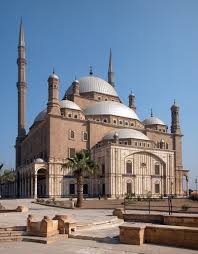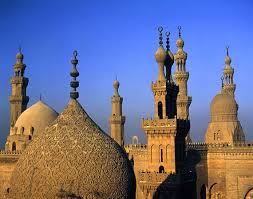Cairo was founded by the Fatimid caliphs as a royal enclosure. It replaced Fustat as the seat of the government. It later came under the Mamluks, was ruled by the Ottomans 1517 to 1798, and briefly occupied by Napoleon. Muhammad Ali of Egypt made Cairo the capital of his independent empire from 1805 to 1882, after which the British took control of it until Egypt attained independence in 1922.
Cairo has a population of about 16.8 million people, according to the 2006 population census.[1] The number of inhabitants was about a million higher at the time of the census, but this was adjusted downwards on the 17th of April 2008 when the new governorate of Helwan was created from parts of a.o. Cairo governorate. Cairo's metropolitan area has a population of about 17.8 million people.[5] Cairo is the sixteenth most populous metropolitan area in the world. It is also the most populous metropolitan area in Africa.[6]
Today, Greater Cairo encompasses various historic towns and modern districts. A journey through Cairo is virtual time travel: from the Pyramids, the Hanging Church, Saladin's Citadel, the Virgin Mary's Tree, the Sphinx, and Heliopolis, to Al-Azhar, the Mosque of Amr ibn al-A'as, Saqqara, the Cairo Tower, and the Old City. It is the Capital of Egypt, and its history is intertwined with that of the country. Today, Cairo's official name is Al-Qahira (Cairo), although the name informally used by most Egyptians is "Masr" (Egyptian Arabic name for Egypt), from the original name of Egypt's first Arab capital Fustat, Misr al-Fustat, "City of the Tents". It is also titled as "The city of a thousand Mazan [(tower in a mosque, i.e. 1000 mosque towers)]".
1- Etymology
The name Al-Qahirah has been said to mean "the Subduer", and it's often translated as "the Victorious". The origin of Al-Qahirah is said to come from the appearance of the planet Mars during the foundation of the City of Cairo. The planet Mars, which in Greek was called Ares, was associated with ruin or destruction and was called Al Najm Al Qahir in Arabic. Al Najm Al Qahir is transliterated as "the destroyer star [planet]". The legacy of the name evolved into “Qahirat Al Adaa” meaning “the subduer of the enemies”. This title was given to the city as many armies were destroyed in attempts to invade Cairo or defeated elsewhere by troops sent from the settlement.
The Arabic word "qa'id" means commander of the castle or fortress. "Alqaida" means base or camp. The root of these words is seen in the Romanized Arabic word "qa'ad", which means to live, dwell, or sit, which in Swahili is "kaa". "Qa" corresponds to the Latin word "cola" meaning seat [tail] and cultivated land. The prefix of Cairo may also mean the landing or the quay, the small hill by the river, that serves as a wharf. In Swahili, "harabu" means to ruin or destroy, and the Persian word "karo" means army or the camp of an army.
2- History
Cairo was founded in 969 AD as the royal enclosure for the Fatimid caliphs, while the actual economic and administrative capital was in nearby Fustat. Modern Cairo encompasses Fustat, as well as other previous capitals — Al-Askar and Al-Qatta'i. Fustat was established by Arab military commander 'Amr ibn al-'As following the conquest of Egypt in 641, and took over as the capital which previously was located in Alexandria. Al-Askar, located in what is now Old Cairo, was the capital of Egypt from 750 to 868. Ahmad ibn Tulun established Al-Qatta'i as the new capital of Egypt, and remained the capital until 905, when the Fustat once again became the capital. After Fustat was destroyed in 1168/1169 to prevent its capture by the Crusaders, the administrative capital of Egypt moved to Cairo, where it has remained ever since. It took four years for the General Jawhar Al Sikilli (the Sicilian) to build Cairo and for the Fatimid Calif Al Muizz to leave his old Mahdia in Tunisia and settle in the new Capital of Fatimids in Egypt.
After Memphis, Heliopolis, Giza and the Byzantine fortress of Babylon-in-Egypt, Fustat was a new city built as a military garrison for Arab troops. It was the closest central location to Arabia that was accessible to the Nile. Fustat became a regional center of Islam during the Umayyad period. It was where the Umayyad ruler, Marwan II, made his last stand against the Abbasids.
Later, during the Fatimid era, Al-Qahira (Cairo) was officially founded in 969 as an imperial capital just to the north of Fustat. Over the centuries, Cairo grew to absorb other local cities such as Fustat, but the year 969 is considered the "founding year" of the modern city.[7]
In 1250, the slave soldiers or Mamluks seized Egypt and ruled from their capital at Cairo until 1517, when they were defeated by the Ottomans. Napoleon's French army briefly occupied Egypt from 1798 to 1801, after which an Ottoman officer named Muhammad Ali made Cairo the capital of an independent empire that lasted from 1805 to 1882. The city then came under British control until Egypt attained independence in 1922.
3- Geography
Cairo is located on the banks and islands of the Nile River in the north of Egypt, immediately south of the point where the river leaves its desert-bound valley and breaks into two branches into the low-lying Nile Delta region.
Referring to Cairo often means Greater Cairo, which is composed of Cairo governate, part of Giza and Qaluobyia governates. Since May 2008 Greater Cairo has been divided into 4 new governates: Cairo, Helwan, Giza and 6th of October. Cairo University is in Giza governate, while Cairo governate has the Ain Shams University.
The oldest part of the city is east of the river. The city gradually spreads west, engulfing the agricultural lands next to the Nile. These western areas, built on the model of Paris by Khedive Ismail in the mid-19th century, are marked by wide boulevards, public gardens, and open spaces. The older eastern section of the city is very different: having grown up haphazardly over the centuries, it is filled with small lanes and crowded tenements. While western Cairo is dominated by tater government buildings and modern architecture, the eastern half is filled with hundreds of ancient mosques.
Extensive water systems have also allowed the city to expand east into the desert. Bridges link the Nile islands of Gezira and Roda, where many government buildings are located and government officials live. Bridges also cross the Nile attaching the city to the suburbs of Giza and Imbabah (part of the Cairo conurbation).
West of Giza, in the desert, is part of the ancient necropolis of Memphis on the Giza plateau, with its three large pyramids, including the Great Pyramid of Giza. Approximately 11 miles (18 km) to the south of modern Cairo is the site of the ancient Egyptian city of Memphis and adjoining necropolis of Saqqara. These cities were Cairo's ancient predecessors, when Cairo was still in this approximate geographical location.
In Cairo, and along the Nile River Valley, the climate is hot desert (BWh) according to the Köppen climate classification system, but often with high humidity due to the river valley's effects. Wind storms can be frequent, bringing Saharan dust into the city during the months of March and April. High temperatures in winter range from the 13°C to the low 20s, while nighttime lows drop to below 10°C, often to 5°C. In Summer, the highs often surpass 40°C, and lows drop to about 20°C. Rainfall is sparse, but sudden showers do cause flooding.
4-Sports
Football is the most popular sport in Egypt, and Cairo has a number of sporting teams that compete in national and regional leagues. The best known teams are Al Zamalek and Al Ahly, whose annual football tournament is perhaps the most watched sports event in Egypt as well as the African and Arabian World. Both teams are known as the "rivals" of Egyptian football, and are the first and the second champions in the African continent and the Arab World. Both teams play their home games at Cairo International Stadium or Naser Stadium , which is Cairo's, Egypt's, Africa's and the Middle East's largest stadium and one of the largest in the world.
The Cairo International Stadium was built in 1960 and its multi-purpose sports complex that houses the main football stadium, an indoor stadium, several satellite fields that held several regional, continental and global games, including the African Games, U17 Football World Championship and was one of the stadiums scheduled that hosted the 2006 African Nations Cup which was played on January, 2006, which Egypt won its title for the record number of five times in African Continental Competition's history.
Cairo failed at the applicant stage when bidding for the 2008 Summer Olympic Games, which was hosted in Beijing, China. However, Cairo will host the Pan-Arab Games this year and next year.
There are several other sports teams in the city that participate in several sports including el Gezira Sporting Club, el Shams Club, el Seid Club, Heliopolis Club and several smaller clubs, but the biggest clubs in Egypt (not in area but in sports) are Al Zamalek & Al Ahly. They have the two biggest football teams in Egypt.
Most of the sports federations of the country are also located in the city suburbs, including the Egyptian Football Association. The headquarters of the Confederation of African Football (CAF) was previously located in Cairo, before relocating to its new headquarters in 6 October City, a small city away from Cairo's crowded districts.
5- Culture
Over the ages, and as far back as seven thousand years, Egypt stood as the land where civilizations have always met. The Pharaohs together with the Greeks and the Romans have left their imprints here. Muslims from the Arab Peninsula, led by Amr ibn al-A'as, introduced Islam into Egypt. Khedive Mohammad Ali, with his Albanian family roots, put Egypt on the road to modernity. If anything, the cultural mix in this country is natural, given its heritage. Egypt can be likened to an open museum with monuments of the different historical periods on display everywhere.
5.1 Cairo Opera House
President Mubarak inaugurated the new Cairo Opera House of the Egyptian National Cultural Center on October 10, 1988, seventeen years after the Royal Opera House had been destroyed by fire. The National Cultural Center was built with the help of JICA, the Japan International Co-operation Agency and stands as a prominent feature for the Japanese-Egyptian co-operation and the deep-rooted friendship between these two nations.
Thus, the joint efforts of Japanese and Egyptians has given rise to a unique landmark which celebrates the rich and diverse cultural life not only of Egypt but of neighboring nations in Africa and the Middle East as well.
Egypt is proud to be the only state in the region which built two opera houses within a bit more than a century.
5.2 Khedivial Opera House
The Khedivial Opera House or Royal Opera House was the original opera house in Cairo, Egypt. It was dedicated on November 1, 1869 and burned down on October 28, 1971. After the original opera house was destroyed, Cairo was without an opera house for nearly two decades until the opening of the new Cairo Opera House in 1988.
5.3 Cairo International Film Festival
Egypt's love of the arts in general can be traced back to the rich heritage bequeathed by the Pharaohs. In modern times, Egypt has enjoyed a strong cinematic tradition since the art of filmmaking was first developed, early in the 20th century. A natural progression from the active theatre scene of the time, cinema rapidly evolved into a vast motion picture industry. This together with the much older music tradition, raised Egypt to become the cultural capital of the Arab world.
For more than 500 years of recorded history, Egypt has fascinated the West and inspired its creative talents from play writer William Shakespeare, poet and dramatist John Dryden, and novelist and poet Lawrence Durrell to film producer Cecil B. de Mille. Since the silent movies Hollywood has been capitalising on the box-office returns that come from combining Egyptian stories with visual effects.
Egypt has also been a fount of Arabic literature, producing some of the 20th century's greatest Arab writers such as Taha Hussein and Tawfiq al-Hakim to Nobel Laureate, novelist Naguib Mahfouz. Each of them has written for the cinema.
With these credentials, it was clear that Cairo should aim to hold an international film festival. This dream came true on Monday August 16, 1976, when the first Cairo International Film Festival was launched by the Egyptian Association of Film Writers and Critics, headed by Kamal El-Mallakh. The Association ran the festival for seven years until 1983.
This achievement lead to the President of the Festival again contacting the FIAPF with the request that a competition should be included at the 1991 Festival. The request was granted.
In 1998, the Festival took place under the presidency of one of Egypt's leading actors, Hussein Fahmy, who was appointed by the Minister of Culture, Farouk Hosni, after the death of Saad El-Din Wahba.
Four years later, the journalist and writer Cherif El-Shoubashy became president.
For 29 years, the home of the Pyramids and Nile has hosted international superstars like Nicolas Cage , John Malkovich, Morgan Freeman, Bud Spencer, Gina Lollobrigida, Ornella Mutti, Sophia Loren, Claudia Cardinale, Victoria Abril, Elizabeth Taylor, Shashi Kapoor, Alain Delon, Greta Scacchi, Catherine Deneuve, Peter O'toole, Christopher Lee, Irene Pappas, Marcello Mastroianni and Omar Sharif, as well as great directors like Robert Wise, Elia Kazan, Vanessa Redgrave, Oliver Stone, Roland Joffe, Carlos Saura, Ismail Merchant and Michel Angelo Antonioni, in an annual celebration and examination of the state of cinema in the world today.
5.4 Cairo Geniza
The Cairo Geniza is an accumulation of almost 200,000 Jewish manuscripts that were found in the genizah of the Ben Ezra synagogue (built 882) of Fostat, Egypt (now Old Cairo), the Basatin cemetery east of Old Cairo, and a number of old documents that were bought in Cairo in the later 19th century. These documents were written from about 870 to as late as 1880 AD and have now been archived in various American and European libraries. The Taylor-Schechter collection in the University of Cambridge runs to 140,000 manuscripts; there are a further 40,000 manuscripts at the Jewish Theological Seminary of America.
6- Gallery












